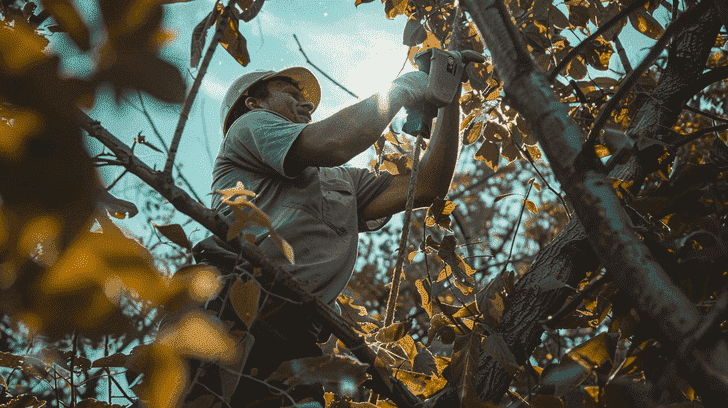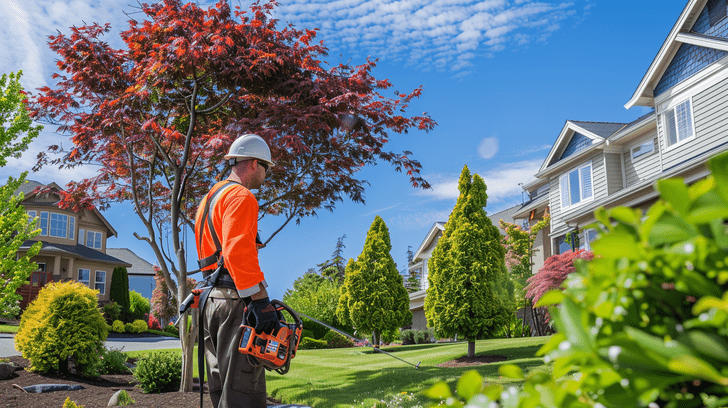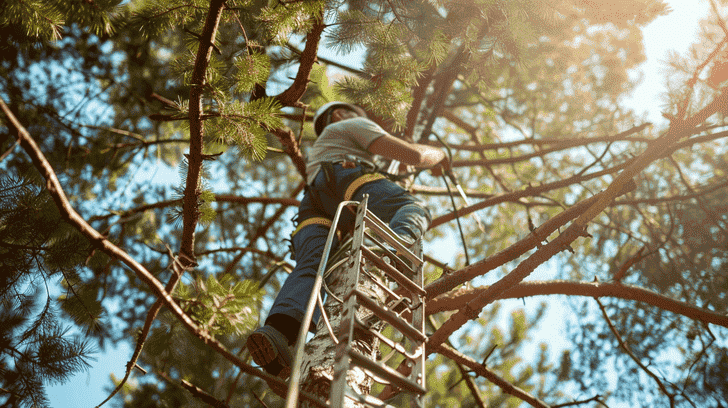How Much Does Tree Trimming Cost? [+Calculator]
The average cost to trim a tree in the United States falls between $255 and $655 per tree. However, this is a broad range and the actual cost can vary depending on several factors.
Keeping your trees healthy and beautiful often involves regular trimming. Trimming removes dead, diseased, or overcrowded branches, improves the tree’s structure, and promotes healthy growth.
It can also enhance your property’s aesthetics and even increase curb appeal. However, the cost of tree trimming can vary depending on several factors. This guide will help you understand what to expect and how to get the best value for your money.
Factors Influencing Tree Trimming Costs:
Several key factors influence the overall cost of tree trimming. These include:
Tree Size: Generally, larger trees require more time and labour to trim, leading to higher costs.
Tree Condition: Trees with extensive deadwood removal or significant disease issues may require more complex trimming techniques, increasing the price.
Location: Tree trimming companies in areas with a high cost of living often charge more than companies in rural areas.
The following table provides a general estimate of tree trimming costs based on size:
Tree Size Average Cost Range
| Small (less than 20 ft.) | $75 – $200 |
| Medium (20 – 40 ft.) | $125 – $500 |
| Large (over 40 ft.) | $150 – $700+ |
Average Tree Trimming Costs
Understanding the average cost range for tree trimming is a valuable starting point for budgeting.
However, it’s important to remember that these are just averages, and your actual cost may vary depending on the specific factors discussed earlier.
Here’s a breakdown of national average costs to give you a general idea:
National Average Cost Range:
Generally, tree trimming services across the United States fall within a range of $255 to $655 per tree. This broad range reflects the influence of various factors like location, tree size, and complexity of the job.
Cost per Tree Size:
The size of the tree is one of the most significant cost determinants. Here’s a more detailed breakdown of average trimming costs based on tree size:
Small Trees (under 20 feet): These trees typically require minimal work and can be trimmed for $75 to $200. This might involve removing a few dead branches or shaping a small ornamental tree.
Medium Trees (20 to 40 feet): As the tree size increases, so does the complexity of trimming. For medium-sized trees, expect a cost range of $125 to $500. This might involve removing larger branches, thinning the canopy, or addressing minor crown reduction needs.
Large Trees (over 40 feet): Large, mature trees require the most time, labour, and potentially specialized equipment for trimming. The cost for large trees can range significantly from $150 to over $700. Trimming a large tree might involve extensive deadwood removal, crown thinning, shaping, or even significant reduction cuts.
Average Tree Trimming Cost by Type of Trees in USA
| Tree Type | Average Cost Range | Notes | |
| Oak | $350 – $1,385 | Price varies depending on species (red oak vs. live oak) and size. | |
| Pine | $175 – $1,765 | Fast-growing pines may require more frequent trimming, impacting cost. | |
| Palm | $185 – $1,215 | Trimming cost depends on palm variety (fan palm vs. coconut palm) and height. | |
| Cypress | $150 – $1,200 | Bald cypress and Italian cypress have different trimming requirements. | |
| Maple | $250 – $875 | Sugar maple and red maple may have slightly different average costs. | |
| Fruit Trees (Apple, Pear, etc.) | $125 – $500 | Regular pruning is essential for fruit production, impacting cost. | |
| Flowering Trees (Dogwood, Crape Myrtle) | $100 – $475 | Trimming focuses on maintaining bloom potential and overall shape. | |
| Evergreens (Spruce, Fir, etc.) | $200 – $700 | Shaping and maintaining a healthy evergreen form affects the cost. |
Additional Cost Factors
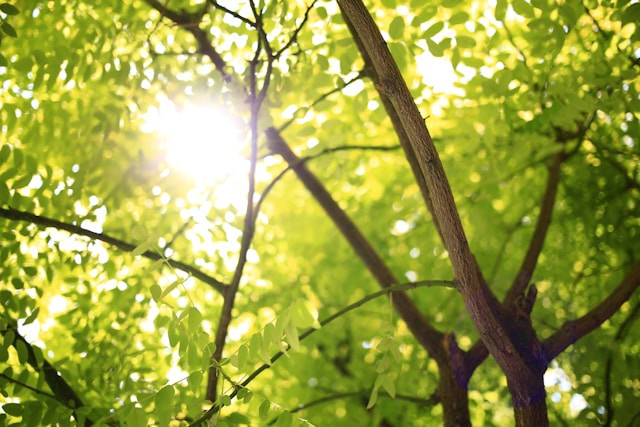
Beyond the base cost influenced by tree size, several additional factors can affect your final tree trimming bill:
Number of Trees: Trimming multiple trees on your property typically incurs a discount per tree compared to a single tree. However, extensive trimming on several trees can still result in a significant total cost.
Tree Species: Rare or special tree species may require specialized knowledge or equipment for trimming, leading to higher costs.
Accessibility: Trees with difficult access due to power lines, landscaping features, or surrounding buildings might require additional labour or equipment, impacting the price.
Trimming Complexity: Simple trims that focus on removing dead branches are less expensive than complex shaping or crown reduction procedures.
Debris Removal: Some tree trimming companies include debris removal in their quote, while others charge extra. Be sure to clarify this point before finalizing a service agreement.
Understanding these additional cost factors will help you anticipate the final price and compare quotes from different tree-trimming companies more effectively.
Local Cost Variations
The cost of tree trimming can also vary depending on your location. Here’s why:
Geographical Differences: Areas with a higher cost of living typically have higher tree-trimming prices due to factors like labour costs and insurance rates.
Insurance and Licensing Requirements: Tree trimming companies are required to carry specific insurance and licenses to operate legally. These costs can vary by location and may be reflected in the final service price.
Getting Quotes and Hiring a Professional
Once you understand the factors influencing tree trimming costs, it’s crucial to get quotes from several reputable tree trimming companies in your area.
When comparing quotes, consider not just the price, but also:
Qualifications and Insurance: Ensure the company has certified arborists on staff and carries proper insurance coverage.
Experience with Your Tree Species: Look for companies with experience trimming trees similar to yours.
Written Contract: Always get a written contract outlining the scope of work, estimated cost, and payment terms before hiring a tree trimming company.
By following these tips, you can ensure you’re hiring a qualified professional and getting the best value for your tree trimming needs.
Saving Money on Tree Trimming
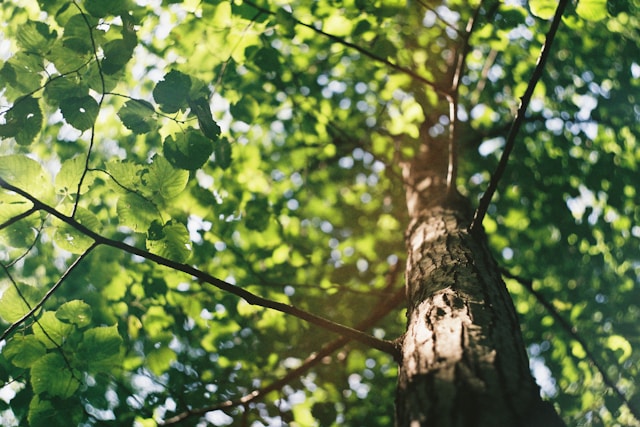
While professional tree trimming is recommended for large, complex jobs, or trees with significant issues, there are ways to save money on smaller trees with basic trimming needs. Here are some options:
DIY Pruning: For healthy, small trees (under 20 feet) with easily accessible branches, you can attempt DIY pruning. However, ensure you have the proper tools, knowledge, and safety gear before attempting any cuts. Improper pruning techniques can harm the tree.
Timing Your Trimming: Many tree trimming companies offer discounts during their dormant season (typically late fall to early spring). Scheduling your trimming during this time can help you save money.
Negotiating with Trimming Companies: Once you have quotes from several companies, don’t be afraid to negotiate, especially if you’re trimming multiple trees. However, prioritize qualifications and experience over the lowest price.
Considering Bartering Services: If you have skills or services you can offer, consider bartering with a tree trimming company. This can be a mutually beneficial way to reduce your overall cost.
Remember: While saving money is important, prioritizing the health and safety of your trees should be paramount. Don’t attempt DIY trimming on large trees or those with complex needs.
Conclusion
Regular tree trimming is an essential part of maintaining healthy, beautiful trees on your property. Understanding the factors that influence tree-trimming costs will help you budget effectively and make informed decisions when hiring a professional.
While the initial cost might seem high, proper trimming extends the life of your trees, reduces the risk of damage from falling branches, and can even increase your property value.
For larger or complex trimming jobs, hiring a qualified and insured tree trimming company is the safest and most effective option. However, for small, healthy trees, DIY pruning or strategic cost-saving measures can be explored.
The key takeaway is to find a balance between cost and the well-being of your trees. Healthy trees add beauty and value to your property, making proper care a worthwhile investment.
FAQ – Tree Trimming Cost
Why is tree trimming so expensive?
Tree trimming can seem expensive due to several factors:
Skilled labour: Certified arborists or experienced trimmers know how to make proper cuts that benefit the tree’s health and avoid harming it.
Safety is a priority: Trimming large trees can be dangerous, and companies need to factor in proper safety gear and procedures to protect their workers.
Time and effort: Trimming a tree can be time-consuming, especially for large or complex jobs, leading to higher labour costs.
Equipment can be expensive: Companies may require specialized equipment like
cranes or chippers for specific trimming tasks, adding to the overall cost.
How much does it cost to trim a large tree?
Trimming a large tree (over 40ft) can range from $500 to over $1,200. The exact cost depends on several factors, including:
Size of the tree: Larger trees require more time and labour to trim, increasing the cost.
Condition of the tree: Extensive deadwood removal or significant disease issues might require more complex trimming techniques, impacting the price.
Complexity of the trimming: Simple trims for deadwood removal are less expensive than crown reduction or shaping procedures.
How often do trees need to be trimmed?
The frequency of trimming depends on the tree species and its growth rate:
Young trees: May need trimming every 3-5 years to establish good structure and growth patterns.
Mature trees: Might only need trimming every 5-10 years, depending on the species and growth rate.
What is the difference between cutting a tree and trimming a tree?
There’s a key distinction between trimming and cutting a tree:
Trimming: Focuses on removing specific branches to improve the health, structure, or aesthetics of the tree. This promotes healthy growth and can involve removing dead, diseased, overcrowded, or poorly placed branches.
Cutting: This involves removing the entire tree, typically as a last resort due to factors like disease, severe damage, or posing a safety hazard.
What months are best for tree trimming?
The ideal months for tree trimming depend on the tree species and your location.
However, late fall to early spring (dormant season) is generally recommended to minimize stress on the tree. During this period, the tree is less vulnerable to insect infestation and disease after pruning cuts.
Is it OK to trim trees in summer?
Summer trimming might not be ideal for all tree species, as it can stress them during hot weather. Some trees may seal wounds slower during the summer months, making them more susceptible to disease. Here’s what to consider:
Tree species: Some species, like oaks, are more tolerant of summer trimming than others.
Climate: In hot, dry climates, summer trimming might be even more stressful for trees.
It’s always best to consult a certified arborist for specific recommendations on the best time to trim your trees.
Should trees be trimmed yearly?
Yearly trimming isn’t necessary for all trees. The frequency depends on the species, growth rate, and overall health.
A qualified arborist can assess your trees and recommend the appropriate trimming schedule for each one.
Some trees may only need trimming every 5-10 years, while young trees establishing structure might benefit from more frequent trimming (every 3-5 years).

